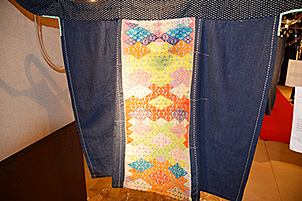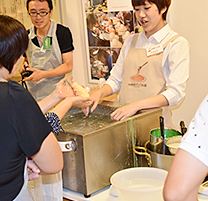 |
Focus features two in-depth reviews each month of fine art, architecture and design exhibitions and events at art museums, galleries and alternative spaces around Japan. The contributors are non-Japanese art critics living in Japan. |
|
|
 |
 |
 |
More Amazing than Amusing: Asakusa's Amuse Museum
Michael Pronko |
 |
|
|
|
| Warm boots made from reused scraps of hemp that are available to touch, play with, and stick one's hands inside. The tactile experience of these pieces brings visitors close to the original owners. |
|
A heavy overcoat that was usually worn inside, especially since some coats weighed up to 14 kilograms. At night families would huddle together inside and drift off to sleep. |
Keep moving past the gift shops, traditional stores, and waves of tourists in Asakusa, and enter an upscale craft store just outside the entrance to the Sensoji temple grounds. Walk to the back and you will find a small ticket counter and a staircase that leads up to one of Tokyo's most unique museums, the Amuse Museum. Inside is a place where you can do two things usually restricted at such institutions: touch everything and take all the photographs you want.
The Amuse Museum does more than amuse, it edifies through excellent displays with wonderful descriptions in Japanese and English (and extensive, clear, and correct English at that) that provide background stories, cultural concepts, and historical explanations. Your imagination works overtime trying to conceive where these diverse works of art and craft came from.
The permanent exhibit, Boro, meaning rags or scraps, comes from the vast textile collection of Chuzaburo Tanaka, an avid collector of folk art, clothes, and other cultural properties. His reputation for collecting genuine household articles, in particular homemade and home-use fabrics, is such that he served as an advisor to filmmaker Akira Kurosawa among others. Tanaka not only has an excellent eye for the works he acquires, but a profound understanding of their meaning.
|
|
|
| This traditional cloth was used for many purposes, but perhaps chief among them was as a blanket on which women would give birth. Generations were born on the same scraps of cloth, re-sewn over and over. |
|
The long robe and pants shown here are composed of scraps, too, but because they were worn outside the home, much more care was put into their appearance. |
If Tanaka had not collected these pieces, they would have been thrown away. The quilts, overcoats, work clothes and other cloth items, all made from scraps, are slightly different from folk art, or mingei -- more like outsider art made without training or artistic intention. These multiply-quilted and repeatedly-patched fabrics were mainly intended for staying warm in the cold northern region of Aomori. However, the magnificent end products boast designs, colors, patterns, and technical skills that are highly artistic.
In old Japan, even cloth fell into a hierarchy. Commoners were forbidden from wearing silk, and in many places from wearing cotton. Ordinary people used hemp, but in northern Japan, the material had to be sewn in thick layers to do any good in the brutal winters. Some of the overcoats weigh 14 kilograms, and were used mainly for the whole family to sleep under. Whatever their function, all the pieces have a tangible energy and liveliness.
What's best about the exhibition is that visitors can sink their fingers into the thick layers of softened hemp or run their hand inside a mitten to feel just what the textiles are like. Especially attractive is the extensive stitching used to re-sew, re-patch, and re-quilt these scraps for generations. There was no concept of recycling because nothing was ever thrown away. That frugality produced works of a marvelous, rough beauty.
|
|
|
| Salmon-skin boots are not only warm but waterproof and non-slippery. Sealskin added to the salmon skin and fins on the sole help to prevent slips when walking on ice. |
|
The special exhibit of maekake aprons from Nanbu, on the Pacific coast of Aomori, shows the tremendous skill with which local women could sew, combining hemp fabric with intricate patterns in wool thread. The exhibit included the names of the women, their families and villages, and what year they were married. |
In addition to the permanent collection, which rotates its displays every few months, the Amuse Museum always has a special exhibit. The current one, which is up until September 28, features the folk-craft items known as maekake, or aprons, from the Nanbu district on the Pacific side of Aomori Prefecture. The aprons hang in the air as if dancing, and yes, you can touch them, too.
The aprons incorporate some wool, which was warmer, easier to sew, and more colorful. But because wool was so expensive, the women who made maekake would often tear one thread into several small threads before sewing. Most interestingly, every one of the pieces bears the name of the woman who sewed the apron and where and at what age she married! Elements like these powerfully convey the sense of a living culture and the people who created it.
The museum also has atelier space for studying such skills as shamisen playing and indigo dyeing. On the second floor, visitors can learn how to make plastic food, the kind that appears in restaurant display windows all across Japan. Reserve ahead if you want to learn the secrets of this handmade craft from a representative of one of the traditional plastic-food companies who come over from nearby Kappabashi Street, the kitchen supply center of Tokyo.
 |
|
 |
|
|
|
| A close-up reveals the intricate embroidery in more detail. The cloth includes indigo-dyed hemp along with cotton fabrics behind the wool embroidery in various colors. In the poorest areas, getting hold of even 10 to 20 centimeters of wool was not easy, so threads were often split into smaller sizes to go farther. |
|
In a special activity space, visitors learn how to make plastic food, one of Japan's most recently developed handcrafts. An expert gives instructions on how to drip the plastic into the water to make the right crinkled texture to create a tempura shrimp that looks almost as mouth-watering as the real thing.
|
All photos by Michael Pronko, by permission and courtesy of the Amuse Museum.
|
The museum also holds Ukiyoe Nights every Thursday in its large event space on the upper floor. These evenings bring together ukiyoe enthusiasts to have a drink and listen to renowned specialists give talks (in Japanese) about these famed Edo-era prints and paintings. On other days, the museum's space opens for Rakugo comic monologues, traditional music concerts, and other events. The first floor shop sells crafts from all over Japan.
The Amuse Museum is a well-conceived, accessible, and fascinating concept. It offers deep insights into the exquisite crafts and artistic sensibilities of Japan in a very intimate way. The museum not only preserves and skillfully displays the living spirit of its collection, but makes it available for visitors to look at, touch, hold, and for a minute or two at least, live with.
|
|
|
|
|
 |
2-34-3 Asakusa, Taito-ku, Tokyo
Phone: 03-5806-1181
Open: 10 a.m. to 6 p.m. (last admission 5:30), closed Mondays
Access: Five-minute walk from Tobu and Tokyo Metro Asakusa Station, one minute from the east side of Sensoji Temple. |
|
|
 |
 |
Michael Pronko
Michael Pronko teaches American literature, film, art and music at Meiji Gakuin University. He has appeared on NHK, Sekai Ichiban Uketai Jugyo, and other TV programs. His publications include several textbooks and three collections of essays about Tokyo. He writes regular columns for Newsweek Japan, ST Shukan, The Japan Times, and for his own websites, Jazz in Japan and Essays on English in Japan. |
|
 |
|